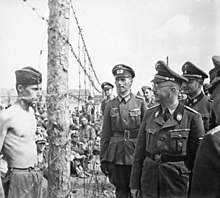Kejahatan Jerman yang dilakukan terhadap tahanan perang Uni Soviet

Pada Perang Dunia II, Jerman Nazi mengadakan sebuah kebijakan perlakuan tak semestinya terhadap tawanan perang Uni Soviet, berseberangan dengan perlakuan mereka terhadap tawanan perang Inggris dan Amerika. Hal ini mengakibatkan sekitar 3.3 sampai 3.5 juta orang tewas, atau 57% dari seluruh tawanan perang Soviet.[1][2][3][4] Pada masa Operasi Barbarossa, invasi Blok Poros ke Uni Soviet, dan kemudian Perang Jerman-Soviet, jutaan tawanan perang Tentara Merah diambil. Beberapa dieksekusi, diarbitrasi di sebuah lapangan oleh pasukan Jerman atau diserahkan ke SS untuk ditembak, di bawah Perintah Komisar; kebanyakan tewas pada pawai kematian dari garis depan atau di bawah kondisi tak berperikemanusiaan di kamp tawanan perang dan kamp konsentrasi Jerman.
Referensi
[sunting | sunting sumber]- ^ Peter Calvocoressi, Guy Wint, Total War — "The total number of prisoners taken by the German armies in the USSR was in the region of 5.5 million. Of these, the astounding number of 3.5 million or more had been lost by the middle of 1944 and the assumption must be that they were either deliberately killed or done to death by criminal negligence. Nearly two million of them died in camps and close on another million disappeared while in military custody either in the USSR or in rear areas; a further quarter of a million disappeared or died in transit between the front and destinations in the rear; another 473,000 died or were killed in military custody in Germany or Poland." They add, "This slaughter of prisoners cannot be accounted for by the peculiar chaos of the war in the east. ... The true cause was the inhuman policy of the Nazis towards the Russians as a people and the acquiescence of army commanders in attitudes and conditions which amounted to a sentence of death on their prisoners."
- ^ Christian Streit: Keine Kameraden: Die Wehrmacht und die Sowjetischen Kriegsgefangenen, 1941–1945, Bonn: Dietz (3. Aufl., 1. Aufl. 1978), ISBN 3-8012-5016-4 — "Between 22 June 1941 and the end of the war, roughly 5.7 million members of the Red Army fell into German hands. In January 1945, 930,000 were still in German camps. A million at most had been released, most of whom were so-called ‘volunteers’ (Hilfswillige) for (often compulsory) auxiliary service in the Wehrmacht. Another 500,000, as estimated by the Army High Command, had either fled or been liberated. The remaining 3,300,000 (57.5 percent of the total) had perished."
- ^ Nazi persecution of Soviet Prisoners of War United States Holocaust Memorial Museum — "Existing sources suggest that some 5.7 million Soviet army personnel fell into German hands during World War II. As of January 1945, the German army reported that only about 930,000 Soviet POWs remained in German custody. The German army released about one million Soviet POWs as auxiliaries of the German army and the SS. About half a million Soviet POWs had escaped German custody or had been liberated by the Soviet army as it advanced westward through eastern Europe into Germany. The remaining 3.3 million, or about 57 percent of those taken prisoner, were dead by the end of the war."
- ^ Jonathan North, Soviet Prisoners of War: Forgotten Nazi Victims of World War II Diarsipkan March 30, 2008, di Wayback Machine. — "Statistics show that out of 5.7 million Soviet soldiers captured between 1941 and 1945, more than 3.5 million died in captivity."
Kesusastraan
[sunting | sunting sumber]- Otto, Reinhard; Keller, Rolf; Nagel, Jens (2008). "Sowjetische Kriegsgefangene in deutschem Gewahrsam 1941–1945: Zahlen und Dimensionen" (PDF). Vierteljahrshefte für Zeitgeschichte (dalam bahasa German) (4): 557–602.
- Bloodlands: Europe Between Hitler and Stalin by Timothy Snyder
- Keine Kameraden: Die Wehrmacht und die Sowjetischen Kriegsgefangenen, 1941–1945 by Christian Streit
- The Policies of Genocide: Jews and Soviet Prisoners of War in Nazi Germany by Gerhard Hirschfeld and Wolfgang J. Mommsen
